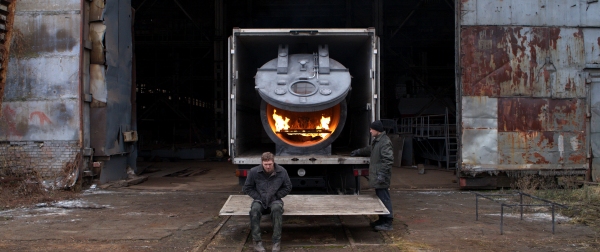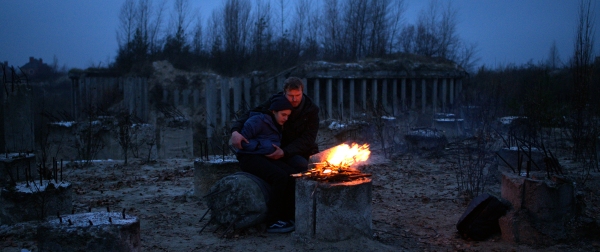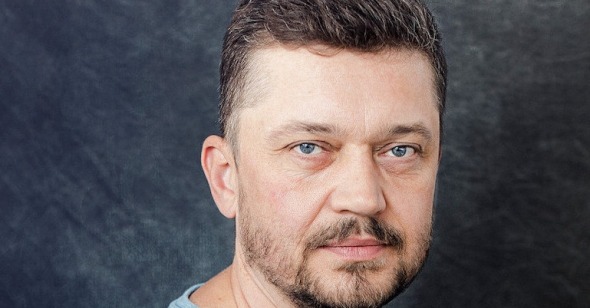Begin Again:
An Interview with Valentyn Vasyanovych (Reflection)
by Leonardo Goi
A four-film Vasyanovych retro played at MoMI March 25–27.
In 2019’s Atlantis, Valentyn Vasyanovych conjured a not-so-distant future where his native Ukraine emerged victorious, if shattered, from war with Russia. Reflection, the director’s fifth and latest feature, takes us back to 2014, the year the conflict broke out in Donbas. Yet the two films seem to emerge from the same purgatory, a world where time has frozen and those who survived the war must still wrestle with its traumatic legacy. The drifter at Reflection’s center is Kyiv-based Serhiy (Roman Lutskyi), whom we first meet at the birthday celebrations for his pre-teen daughter Polina (Nika Myslytska, Vasyanovych’s daughter), together with his ex-wife Olha (Nadia Levchenko) and her new partner Andriy (Andriy Rymaruk). Andriy is a soldier, Serhiy a surgeon; haunted by the dying bodies shipped from the eastern front to his ER and pressured by Polina to “do something about it,” Serhiy finally enlists, only to be captured by Russian forces the moment he reaches war-torn Donbas.
What follows is a stomach-churning descent into hell, as Vasyanovych dogs Serhiy along an unflinchingly brutal series of tortures the man is first subject to, and then forced to assist in. As the prison’s resident doctor, the Russians have him attend their barbaric interrogations, check the vitals of fellow Ukrainian captives, and then shovel their mutilated corpses into an incinerator (a Charon-like role that reminded me of László Nemes’s Son of Saul). By his own admission, Vasyanovych had originally intended Reflection as an anthology of torture, and while the scenes of graphic violence make up a relatively small fraction of the film’s two hours, they are captured with a surgical, almost detached composure. As in Atlantis, Vasyanovych (who here serves multiple roles as the film’s director, writer, editor, coproducer, and cinematographer) crafts the entire film as a succession of static, single-frame shots—29 in total. His camera doesn’t shy away from the most terrifying atrocities, but even those gory details are offset by the glacial beauty of the tableaux that frame them. I don’t mean to suggest Reflection prettifies or numbs the horrors of war, only that the shots’ rigid symmetries speak to a larger project Vasyanovych is possibly after: to interrogate the parallels between the life of a civilian, and how that same life unravels during and after war.
Shipped back to Kyiv after a prisoner swap, Serhiy must wrestle with his PTSD and find the courage to tell Polina and Olha what happened at the front, and why Andriy will never come back. It’s here, in the film’s meditative, somber second half, that Vasyanovych tips his hand. As the focus shifts to Serhiy and his daughter, Reflection raises the same timeless questions that also haunted Atlantis: how do you survive an experience of the kind Serhiy went through? How do you explain the unspeakable, and find a reason to keep on living?
As I write these words, Vasyanovych is still in Ukraine. In a statement to the Odessa Film Festival from February 24, he said he planned to stay in Kyiv, “to be among those who are aware of their ethnic, cultural, and political affiliation,” and “create true stories about them.” A few months back, when Reflection premiered in Venice, we sat to discuss the film and its relationship to what was then only billed as an “ongoing crisis.”
Reverse Shot: I was curious to hear about your writing process, how and where your scripts begin. What was that like in Reflection? Was there a specific image that inspired the whole film?
Valentyn Vasyanovych: The first thing you should know is that I started off as a cameraman; I’ll bring a camera anywhere I go, whether it’s a house party or a stroll with my child. If I see something intriguing, a location that inspires me, I’ll snap a picture. As for Reflection, the film was inspired by a real-life event I witnessed: a pigeon crashing against the window of my house. The impact was so strong the bird died, instantly, and it left this morbidly beautiful mark on the glass, a mix of blood and feathers—stunning, haunting, and cruel all at once. My eight-year-old daughter saw it and was just as shocked as I was. And that’s when she started to ask me questions about life and death. About the meaning of it all. I took the camera and shot a three-minute video where she stands by the window, the pigeon’s imprint still visible. I pitched the whole film with this three-minute clip, and we won! [chuckles] I guess the clip worked.
RS: Do you often find yourself drawing from your real-life experiences for your scripts?
VV: Yes. Reflection is by no means the only film where I’ve done that. Nor is the dead pigeon the only thing I culled from real-life stuff. Later in the film there’s a scene where the protagonist’s daughter falls off her horse and breaks her arm. All of that had happened to my own daughter: she fell off a horse and had to be rushed to the hospital.
RS: I’m sorry to hear!
VV: Oh, she’s better now! [chuckles] But yeah, I often start from things I know and then throw in fictional elements—more drama, more traumas. And I like to think of the editing as a chance for me to help my characters rebuild their lives and find a reason to keep on fighting. I bring in things that happened to me, things I know, and let this . . . let’s call it this “documentary stuff” blend with the fictional bits. That’s how my writing goes, generally. Of course, everything I bring in from my real-life experiences is stuff that I then change and tweak to suit the film and script. Even when the story beats are supposedly autobiographical, they’re still reinvented. Another case in point from Reflection: the scene where father and daughter use pages of a Bible to light up a fire. Once I went to a party and saw a bunch of children struggling to light a fire. They didn’t have enough logs, so this family handed their child a Bible, and the boy began to tear off the pages and use them as fuel. I was just so stunned I turned the camera on and started filming. I should probably stress that the family in question were all atheists.
RS: The way you describe it, your writing sounds like a very porous, almost serendipitous process.
VV: That’s right. I guess that’s something that started with Black Level, my third feature. When I began “working” on it, it was a largely unscripted, unplanned project I decided to embark on with a friend. We started shooting with no idea as to where exactly the project would take us. It was only after we shot ten scenes or so that we were able to think of it as a feature film. Only then did I feel as though the material was finally pulling me in a certain direction, and I finally understood where the story was going. And that’s how we were able to finish the film.
RS: I read that your father was a conductor, and that you too wanted to pursue music for a while. Which is interesting, considering music is seldom used in your films.
VV: And that’s because, much as I love music, that’s not what drew me to cinema, or what interests me about the medium. It’s the visuals. It’s photography. Plus, I think music might, consciously or not, end up thwarting and manipulating your emotional response as a spectator. That’s why I tend to focus on what’s perhaps a purer level of the cinematic form. All that said though, I did use a short musical segment in Reflection: it’s the moment where father and daughter watch a film together. But I only used music there because the scene just wouldn’t work without it.

RS: Let’s talk about casting. I was so happy to see you work again with Andriy Rymaruk, whose presence in Atlantis made that film so much more haunting. I know he didn’t have a background in acting before you two met, while Roman Lutskyi does. How did you find working with the two in Reflection?
VV: As you can imagine, it was wildly different. Before I met and cast him for Atlantis, Andriy had no prior acting experience. And I still think that, in a way, he doesn’t act so much as exist on stage. He is what he brings to the screen. And that’s what makes working with him so special. As for Roman, he’s a professional actor, and as a result of that he’s arguably much more elastic. He likes a challenge and relishes the creative process as much as I do: he loves creating his characters, not merely embodying them. I first saw Roman in a couple of commercial films, back home, and had a sense he could play a different, possibly more complex role than that. I saw his intellectual side, an ability to reflect and doubt and ache. I wanted to use that. Except when I cast him, the story was very different! The guy he’d play was meant to be a political consultant, not a surgeon. But when I cast Roman I realized that the whole political consultant idea didn’t quite work. The way we’d first imagined him, our protagonist was meant to be a know-it-all kind of character, an assured, grounded figure. Roman’s tragic hero is everything but. So I tweaked the script, and gave him a new job. But this was only after I sat down with Roman and got a better sense of his personality. One thing I’d like to stress is that he was immensely committed to the project. When we first met, I told him he’d have to drop all other gigs just to prepare for our shooting—and he did! He even rented an apartment close to my place so that we could work together more easily.
RS: I know Andriy has fought the Russians in Donbas. Is Roman a veteran, too?
VV: No, he isn’t. While Andriy served as a member of our army’s intelligence department, and since he came back from the front he’s worked for the Come Back Alive foundation, providing technical know-how for our troops.
RS: As with Atlantis, you played many roles here: you’re the film’s director, writer, cinematographer, editor, and one of its producers. How do you feel about juggling so many different tasks?
VV: In all fairness, combining different roles feels very natural. I just think they all coexist within me and complement each other. I find it a lot easier to work on my own instead of having to explain things to a cameraman—things I often can’t verbalize myself. So much of my creative process unfolds as a search: whenever I get to work on a new film, I like to start by scouting locations first and see how those places can speak to and influence my scripts. It’s an eternal, restless quest. An experiment.
RS: There were scenes that shocked me not just for the horrors they showed but also for the technical difficulties they must have involved. I’m thinking of the first time your camera moves, 30 minutes in, for a traveling shot that follows Serhiy down a torture chamber. It’s all a continuous take, and it’s so impeccably choreographed I can’t imagine the kind of rehearsing you went through.
VV: I always find it very challenging to compress several scenes into one cut, one sequence. And that’s just what we did with the scene you mentioned. We shot four scenes in that location. The place is actually a factory: we shot in the basement and then in another part of the building. As to how we did it, it all comes down to endless rehearsing and searching. Searching is key. I know there are many directors who love to work with actors and spend a lot of time talking to them. And others who love tinkering with scripts. Personally, I’m neither one nor the other. I think of myself as a cameraman, and that’s what I mean when I say I like to start with images. I like to visualize a scene in my head first, play it over and over, tweak it, reassemble it. And then, once I get together with my crew, we bring it to life.
RS: I was also quite intrigued by the film’s use of windows. We see them everywhere: the huge window in Serhiy’s flat, the glass panel of his ER room, his car’s windshield, or again the observation window at the paintball park, where Polina plays with her friends. They seem to function as shields, in a way, mediating and protecting us from some of the horrors we see.
VV: Perhaps. But I’m not so sure how symbolic a role they play. As in, I don’t necessarily think they shield us, or protect us. But I do love large-scale, intra-frame compositions—that’s something my films often play with. And I like windows for the depth they can give to a frame. I’m not going to lie—I was a little perplexed when I realized just how many windows there were in the film, and the similar stylistic choices they evoked. But it was the right choice for the medium and long shots I used, and for the mise-en-scène and symmetries I was after.
RS: Those symmetries and beautiful tableaux stand in stark contrast to the violence you show. I must confess there were moments when I had to look away.
VV: I can assure you the cruelty I show in the film pales before what’s happened and is still happening inside prisons controlled by Russian forces in occupied Ukraine. We had the fortune of working with Stanislav Assev, who served a consultant on the film. He’s a Ukrainian journalist who worked for Donetsk’s Radio Liberty and spent two-and-a-half years in one such penitentiary, a prison called Isolation. He even wrote a book about his captivity [In Isolation: Dispatches from Occupied Donbas]. He’s one of a few who were captured by the Russians and eventually returned home and told us about the horrors and torture he went through. I wanted to show these atrocities to remind Europe, and the whole world, that these barbarities aren’t happening far away, in some distant past, but right here, right now. If we don’t resist the Russian invasion, Ukraine will disappear as an independent state, and the countries of the former Socialist Bloc will be next. No one is immune to this aggression.

'
